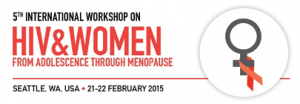Adolescents at increased risk of vertical transmission and poor pregnancy outcome in South Africa
1 June 2015. Related: Conference reports, Women's health, Pregnancy, Intl Workshop on HIV and Women 5th 2015.
Adolescent pregnant women had an increased risk of vertical transmission of HIV and poorer maternal and infant outcomes, compared to non-adolescent women, in a high HIV prevalence district in South Africa.
The study, presented at the 5th International Workshop on HIV and Women, followed a cohort of HIV positive pregnant women and their infants at three urban sentinel surveillance facilities between January 2009 and March 2012. Enhanced routine individual clinical data were captured electronically. Adolescents were defined as 19 years or younger at their first antenatal visit. Multivariate models were used to compare outcomes between adolescents and women above 19 years of age.
The evaluation included 956 mother-infant pairs, of whom 65 (6.8%) were adolescents. At baseline the adolescents were a median age of 18 years (range 13 to 19) and the older women were 28 years (20 to 44). Their baseline CD4 count was 350 cells/mm3 (IQR 233 to 489) and this was similar between age groups, p=0.16. The median gestational age at booking was 22 weeks (IQR 17 to 27) and was similar between groups, p=0.64.
Treatment or PMTCT prophylaxis was according to WHO guidelines. ART eligible at <200 CD4 cells/mm3 before 2010 and <350 cells/mm3 from April 2010. Ineligible women received AZT from 28 weeks and single dose NVP in labour, and AZT from 14 weeks, single dose NVP and TDF/FTC to cover NVP tail during the respective time periods. Infants received NVP.
Adolescents were more likely to be unaware of their HIV status when booking: 75.4% vs 48.3%, adjusted risk ratio (aRR) 1.56 (95% CI: 1.34 to 1.82). They also were more likely not to be on ART at booking: 100% vs 82.8%. Median time of starting ART after first antenatal visit was 64 days (IQR 28 to 92) vs 36 days (IQR 20 to 62) for adolescents vs older women.
Adolescents were at increased risk of not receiving ART by delivery, aRR 1.32 (95% CI: 1.23 to 1.38), of being unbooked before labour, aRR 3.24 (95% CI: 0.96 to 10.9) and increased maternal mortality, aRR 35.1 (95% CI: 2.89 to 426).
Stillbirth among adolescent and older women was 9.4% and 4.5%, respectively, aRR 3.40 (95% CI: 1.61 to7.20). Vertical transmission at 6 weeks was 8.3% and 3.1% amongst infants of adolescent and older women, respectively, aRR 2.94 (95% CI: 1.01 to 8.60).
The study investigators emphasised that interventions targeting adolescents are increasingly needed if South Africa is to attain its Millennium Development Goals.
Reference:
Fatti G et al. Adolescents at increased risk of mother to child transmission of HIV in South Africa. 5th International Workshop on HIV & Women, 21–22 February 2015, Seattle. Oral abstract 05.
http://regist2.virology-education.com/2015/5thHIVwomen/11_Shaikh.pdf (PDF)


